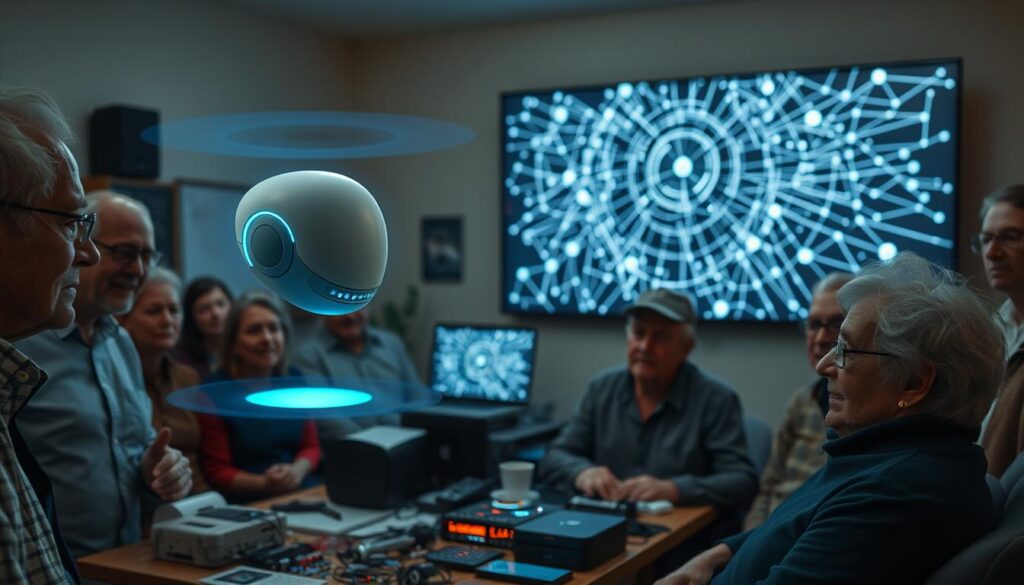5 shocking Reasons Why Older People Resist Learning AI Tools
15 min read
Table of Contents
Artificial Intelligence (AI) is changing our lives in many ways. You’ll encounter it in tools like Siri and connected home gadgets. However, younger and older generations engage with AI tools in very different ways. Younger people easily take to these new technologies, but older adults are more cautious.
So here is the question: Reasons Why Older People Resist Learning AI Tools?

This hesitation isn’t just about being afraid of technology. It’s about many things, like being familiar with it, seeing its value, and how easy it is to use. Grasping these factors is essential to ensuring AI tools are accessible and user-friendly for every age group.
The Growing Generational Divide in AI Adoption
AI is becoming a big part of our lives, but there’s a big gap between older and younger people. Even though more older adults are online, they use fewer apps and spend less time online than the young. This shows a clear divide.
Current Statistics on AI Usage Across Age Groups
A recent survey showed a big gap in AI use between ages. Younger people are more into AI tools, while older folks are not as familiar. Here are some key points:
- Younger adults (18-24 years) are more likely to use AI-driven applications.
- Older adults (65+ years) are less likely to adopt AI technology.
- The gap in AI adoption between younger and older adults is widening.
The Widening Technology Gap in American Society
The technology gap in America is not just about having access. It’s also about knowing how to use AI tools well. As AI grows, those who can’t use it will be left out.
Recent Studies Highlighting the Digital Age Divide
Studies have found that older adults face big hurdles in using AI. They struggle with being new to tech, fear of it, and finding it too complex. It’s important to tackle these issues to close the digital gap.
Key challenges include fear of technology, not knowing how to use it, and finding AI too complicated. To help, there are programs teaching seniors about AI. These efforts aim to narrow the gap.
Fear of the Unknown: Technology Anxiety Among Seniors
As AI becomes more common, seniors feel uneasy about using it. For many, AI seems like a big unknown. Those who didn’t grow up with smartphones or the internet often fear technology.
Understanding Technophobia in Older Generations
Technophobia in seniors is complex. It comes from not knowing technology well, fear of change, and worries about learning new things. The fast pace of tech makes it hard for them to keep up.
Key factors contributing to technophobia include:
- Lack of early exposure to technology
- Fear of appearing incompetent
- Concerns about privacy and security
How Fear Impacts Willingness to Learn New Technologies
The fear of technology makes seniors less likely to learn new things. When faced with something new, they might feel scared or overwhelmed. This stops them from using AI and other tech, making them feel left out.
Addressing this fear requires a multifaceted approach. We need education, support, and tech that’s easy for seniors to use.
Recent Cases of AI Anxiety Among 65+ Age Group
Recent studies show many seniors worry about AI. A study found that a lot of people over 65 are scared of AI devices. They worry about how complicated they are and feeling out of control. This shows we need to help seniors feel more comfortable with AI.
By tackling the reasons behind technophobia and AI anxiety, we can make the digital world more welcoming for seniors.
Perceived Complexity of AI Systems
AI keeps getting better, but it’s hard for older adults to use it. The tools are complex, with lots of technical words and steps. This makes them feel overwhelmed.
Why AI Tools Appear Overwhelming to Older Adults
AI tools are hard to learn, with terms like “machine learning” and “natural language processing.” People who aren’t used to fixing tech find it tough. There are too many features and settings, causing confusion.

The Role of User Interface Design in Accessibility
How AI looks and works is key for older adults. A good design makes AI easy to use. But bad design makes it harder, keeping older adults away.
Cognitive Load Challenges with Modern AI Applications
Today’s AI apps need a lot of brain power to figure out. This is hard for older adults, who might not think as fast. Making AI easier to use can help them.
Concerns About Privacy and Security
As AI becomes more common in our lives, older Americans are worried about privacy and security. They have good reason to be concerned, given all the data breaches and cyber-attacks we’ve seen.
Data Privacy Worries Among Older Americans
Older adults have seen many technologies come and go. They are naturally cautious about AI. They worry about data privacy because they are less familiar with the digital world.
Trust Issues with AI-Powered Applications
Many older adults don’t trust AI apps because they’re not clear about how they handle data. They tend to shy away from AI when its processes aren’t clearly explained to them. Building trust is key, through clear data handling and strong security.
Recent Data Breaches Reinforcing Security Concerns
Recent data breaches have made older adults even more concerned about security. These breaches show the risks of AI and the need for strong security. AI developers must focus on security and privacy to win the trust of older adults.
The “I’ve Managed Without It” Mindset
Many older adults feel they don’t need AI tools. They believe their old ways are good enough. This thinking is common when they think about using new technology.
Resistance Based on Perceived Lack of Necessity
Seniors often think they’ve done fine without AI tools. They rely on what they’ve always done. This is because they’ve learned to live with their current ways.
Demonstrating the value of AI tools to them is key. We need to show how AI can make their lives better. It’s about solving problems and improving their daily lives.
The Challenge of Demonstrating AI’s Value to Seniors
It’s hard to explain why AI tools are good for older adults. We must show how AI can help with health, money, and staying in touch with loved ones.
Case Studies: When Traditional Methods Meet Modern AI
Looking at how AI tools compare to old ways can help. For example, AI in health care can give more tailored care. This is better than what they’re used to.
By understanding this mindset, we can make AI tools more appealing to seniors. We can find ways to make them see the benefits of using AI.
Physical and Cognitive Barriers to Learning
The natural aging process can lead to physical limitations. These make it hard for seniors to use digital technologies. Many older adults face big barriers when trying to learn and use AI tools.
Age-Related Challenges Affecting Technology Adoption
As we get older, shifts in our physical abilities and cognition can make using technology more challenging. Common examples are reduced vision, hearing impairments, diminished dexterity, and slower cognitive processing. These changes make it tough for seniors to use complex digital interfaces.
Key age-related challenges include:
- Diminished visual acuity and hearing
- Reduced dexterity and hand-eye coordination
- Cognitive decline and memory loss
Accessibility Issues in Current AI Tool Design
Many AI tools are made for younger users, ignoring older adults’ needs. This leads to interfaces that are hard for seniors to use.
How Physical Limitations Impact Digital Engagement
Physical limitations can greatly affect a senior’s digital engagement. For example, shaky hands make touchscreens hard to use. Hearing loss also makes voice-activated AI assistants less useful.
To address these challenges, it’s key to make AI tools accessible and easy for seniors to use. This means designing interfaces with bigger fonts, clearer audio, and simpler navigation.
Reasons Why Older People Resist Learning AI Tools: A Deeper Analysis
Why older people resist learning AI tools is complex. It involves looking at social and economic factors. Their hesitation to use AI technology is not just about personal choice. It’s shaped by many different factors.
Sociological Factors Behind Resistance
One big reason is the sense of responsibility older people feel. They might see AI tools as a danger to local businesses and community life. For example, they might worry that online shopping hurts the town centers where they meet friends.
Economic Considerations and Access Disparities
Economic factors also matter a lot. The cost of AI tools and learning how to use them can be too high for many seniors.
Cost Barriers to AI Tools and Training
The price of AI devices and training can be a big problem. Many older people have fixed incomes. This makes it hard for them to buy new tech or take training classes.
Digital Divide in Rural vs. Urban American Communities
There’s also a big difference in digital access between rural and urban areas. Rural places often have poor internet and less tech. This makes it harder for older adults there to learn about AI. Even in cities, there are issues with cost and getting to places that offer training.
To help older adults use AI tools, we need to address these social and economic issues. By understanding and solving these problems, we can make the digital world more welcoming for everyone.
Lack of Tailored Educational Resources
Older adults struggle to learn AI because there’s a lack of educational materials for them. Most resources are made for younger people. This leaves seniors with few options that meet their needs and learning speed.
The Shortage of Age-Appropriate Learning Materials
Most AI learning materials are made for younger people. They use complex language and assume a level of tech knowledge that many seniors don’t have. This makes it hard for older adults who want to learn but can’t find the right resources.
Key challenges include:
- Complex technical language
- Lack of step-by-step instructions
- Insufficient visual aids
Why Traditional Tech Education Fails Older Learners
Traditional tech education doesn’t meet the needs of older adults. It doesn’t consider cognitive decline, limited exposure to technology, and different learning styles. This makes it hard for seniors to learn.
Tools like SumiNote-en help by providing real-time transcription and personalized notes. They show how technology can support senior learning if it’s designed for them.
Emerging Senior-Focused AI Training Programs
New training programs are being made for seniors. They have simple, intuitive interfaces and patient, guided instruction. For example, community centers offer AI workshops for seniors, and online platforms have step-by-step tutorials.
These new programs are a positive step towards making AI education more inclusive. They acknowledge that learners of every age have unique needs.
Successful Initiatives Breaking Down Barriers
To help older adults use AI, many programs have been started. These efforts make AI easier and more welcoming for seniors. They tackle the challenges that stop older adults from learning and using AI.

Community Programs Making AI Accessible to Seniors
Community centers and groups focused on seniors are introducing AI. They offer workshops and classes to teach seniors about AI devices and apps. These programs not only teach but also provide a place for seniors to share and learn together.
Key components of these community programs include:
- Basic AI literacy classes
- Hands-on experience with AI devices
- Discussion groups on AI safety and security
Tech Companies Developing Senior-Friendly AI Interfaces
Tech companies are also key players. They’re making AI interfaces easier for seniors. This includes bigger fonts, simpler navigation, and voice commands. Amazon and Google have added features for older adults, like easy modes on their smart speakers.
The importance of user-centered design is huge. It helps seniors adopt AI more easily. By making AI tools simple and accessible, tech companies help overcome adoption barriers.
Intergenerational Learning: How Family Support Changes Adoption Rates
Intergenerational learning is another great strategy. When younger family members teach seniors about AI, it speeds up their learning. It also strengthens family bonds and makes learning fun.
Benefits of intergenerational learning include:
- Increased confidence in using AI technologies
- Improved digital literacy among seniors
- Stronger family bonds through shared learning experiences
Conclusion: Bridging the AI Divide for an Inclusive Future
Older adults’ hesitation towards AI tools isn’t about rejecting progress. It’s about real barriers like fear, distrust, physical, and cognitive challenges. It’s key to understand these barriers for a more inclusive future.
Many factors make it hard for seniors to use AI, like technophobia and privacy concerns. We need a mix of education, user-friendly AI, and learning across generations. This approach can help.
Working to close the AI gap means older adults won’t be left out in the tech world. Programs and tech companies making AI easier for seniors are good starts.
To make AI work for everyone, we must tackle the unique hurdles older adults face. This way, AI can truly enhance lives for all ages.
FAQ
What are the main reasons why older people resist learning AI tools?
Older adults may feel scared of new technology. They might think AI is too complex. They worry about privacy and security too.Physical and mental challenges also play a part. They might not see the need for AI tools.
How does technophobia affect older adults’ willingness to learn AI technologies?
Technophobia, or fear of technology, makes older adults hesitant. It makes them less likely to try new AI tools.
What role does user interface design play in the accessibility of AI tools for older adults?
User interface design is key for older adults. Bad design can make AI hard to use. It adds to their mental effort.
How do recent data breaches impact older adults’ trust in AI-powered applications?
Data breaches make older adults more cautious. They worry about sharing personal info with AI apps.
What are some successful initiatives that have helped make AI more accessible to older adults?
Community programs and senior-friendly AI interfaces have helped. So has intergenerational learning. These efforts have boosted AI adoption among older adults.
Why do traditional tech education methods often fail older learners?
Traditional tech education doesn’t meet older adults’ needs. It lacks materials for their age group. It doesn’t address their unique challenges.
What are some of the sociological factors that contribute to older adults’ resistance to AI adoption?
Economic factors and access issues affect older adults. Some can’t afford or access AI tools. This limits their use.
How can AI tools be designed to be more accessible to older adults with physical limitations?
AI tools can be made easier for older adults. Use voice commands, large text, and simple navigation. This helps them use digital tech.
What is the impact of the digital divide on AI adoption among older adults in rural vs. urban communities?
The digital divide affects older adults differently. Rural areas face more tech and internet access issues. This hinders AI adoption.
How can intergenerational learning help increase AI adoption among older adults?
Intergenerational learning is key. Younger family members can help older adults learn AI. This support boosts AI adoption.
Reader Ratings & Reviews
There are no reviews yet. Be the first one to write one.
